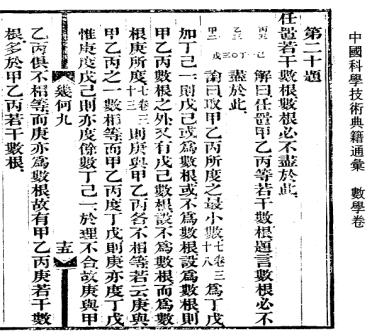 prime numbers than A, B, C.
prime numbers than A, B, C.數學文本與問題意識
台師大數學系
洪萬生教授
本學期『數學史』課程結束前,為了檢驗選修學生是否理解『問題意識』之重要性,特別複印文本一份,請他們提出有意義的數學問題與歷史問題各一個。茲先引述此一文本如下:
Proposition 20: Prime numbers are more than any assigned multitude of prime numbers.(命題20:任置若干數根,數根必不盡於此)
Let A, B, C be the assigned prime numbers;
I say that there are more
 prime numbers than A, B, C.
prime numbers than A, B, C.
For let the least number
measured by A, B, C be
taken,
and let it be DE;
let the unit DF be added to DE.
Then EF is either prime or not.
First, let it be prime;
then the prime numbers A, B, C, EF have been found which are more than A, B, C.
Next, let EF not be prime;
therefore it is measured by some prime number. [VII. 31]
Let it be measured by the prime number G.
I say that G is not the same with any of the numbers A, B, C.
For, if possible, let it be so.
Now A, B, C measure DE;
therefore G also will measure EF.
But it also measures EF.
Therefore G, being a number, will measure the remainder,
the unit DF:
which is absurd.
Therefore G is not the same with any one of the numbers A, B, C.
And by hypothesis it is prime.
Therefore the prime numbers A, B, C, G have been found which are more than the assigned multitude of A, B, C.
Q. E. D. [Heath 1956, vol. II, p. 412]
此一命題正是歐幾里得《幾何原本》(The Elements) 第九冊第二十個定理。眾所周知,本書第七、八、九三冊內容是『數論』(arithmetica),其中第七冊就包括了鼎鼎大名的『輾轉相除法』(Euclidean algorithms),為自然數(希臘人稱為 (whole) number)的因數與倍數之關係,提供了討論的起點。不過,上述定理的特殊表達形式,不僅數學家很少察覺,即使數學史家也常常輕忽待之,實在有一點說不過去。
究其原因,數學教科書(不管高中或大學階段)的通用形式固難辭其咎也,這是因為此一定理都被寫成:『存在有無限多個質數』(There are infinitely many prime numbers),以是,讀者一旦從純粹知識論的角度來研讀《幾何原本》,就很難體會古希臘數學家處處迴避『無限』的無奈與苦心。其實,『無限』即使只當副詞使用,也不曾出現在《幾何原本》之中,譬如平行線之定義,就以下列形式給出:
Parallel straight lines are straight lines which, being in the same plane and being produced indefinitely in both directions, do not meet one another in either direction. [Heath 1956, vol. I, p. 154]
顯然,“indefinitely” 再怎麼推敲,都不好按 “infinitely” 的意義來翻譯,何況後者的使用,根本經不起伊利亞學派 (Eleatics) 哲學家如Parmenides 與 Zeno的挑剔。
 另一方面,仔細考察此一『歐式證法』,我們可以發現時髦的『教科書證法』完全脫胎自於此
- 實質上都利用『歸謬法』!不同之處僅在『修辭』而已:後者『假設』結論不能成立,亦即只有有限多個質數,前者則不須作此假設,將指定的質數寫出即可。從數學認知的角度來看,《幾何原本》的命題表達形式,似乎很容易讓我們聯想到上述『歐式證法』,至於『教科書證法』在作結論無法證出的假設時,似乎無法引導我們必然寫下那有限多個質數。因此,貼近文本就此一例子來說,受惠的不僅歷史研究而已,對學習數學知識本身而言,有時也帶來非常深刻的啟發!
另一方面,仔細考察此一『歐式證法』,我們可以發現時髦的『教科書證法』完全脫胎自於此
- 實質上都利用『歸謬法』!不同之處僅在『修辭』而已:後者『假設』結論不能成立,亦即只有有限多個質數,前者則不須作此假設,將指定的質數寫出即可。從數學認知的角度來看,《幾何原本》的命題表達形式,似乎很容易讓我們聯想到上述『歐式證法』,至於『教科書證法』在作結論無法證出的假設時,似乎無法引導我們必然寫下那有限多個質數。因此,貼近文本就此一例子來說,受惠的不僅歷史研究而已,對學習數學知識本身而言,有時也帶來非常深刻的啟發!
最後,謹引錄此一文本的中譯,它出自李善蘭 (1811-1882) 與偉烈亞力 (Alexander Wylie) 合譯的《幾何原本》後九卷,儘管他們根據的英文母本不詳,然而,我們還是可以讀出譯文的忠實程度(請注意:其中『數根』即「質數」也)。